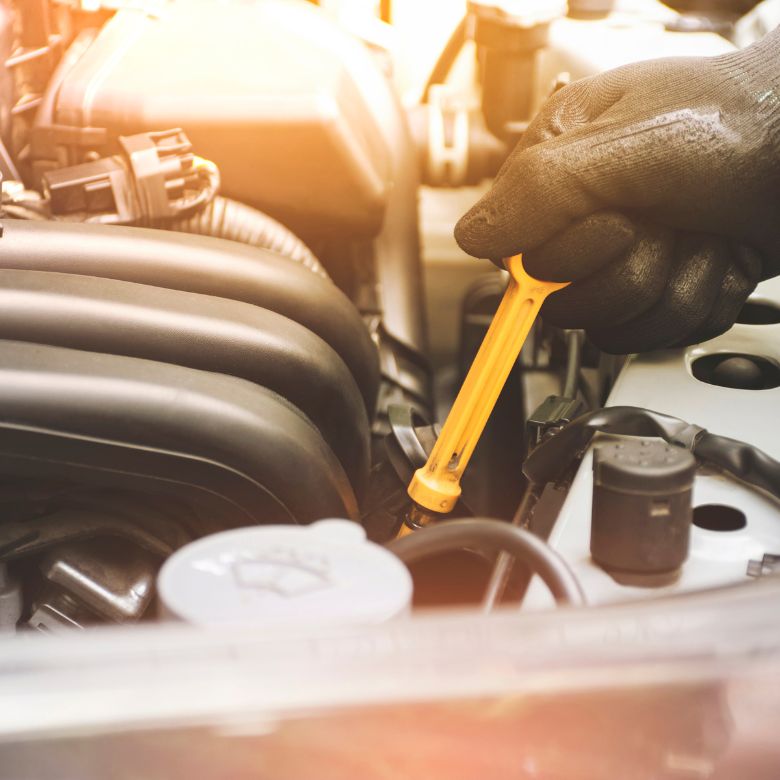Do chemistry and chemical compounds play an important role in cars and the entire automotive industry? Definitely yes! Without a doubt, they are one of its key elements. They are used in many applications, from lacquers, bumpers and headlights to interior seats, dashboard components and seat belts. Fuels are mixtures of many chemical compounds, as are the lubricants used for proper operation of the vehicle. Therefore, it is worth learning where we can find chemistry in our car and getting to know it better.

What can we use to build a car?
Although the heart of every car is the engine that by and large determines the dynamics of the entire vehicle, an equally important role is played by other components, including the body. The material it is made of is a combination of knowledge and experience in chemistry, physics, and materials engineering. Although steel is still the basic material used in car bodies, the use of composites, polymers and even some recycled waste is growing in popularity.
Most body elements are made of rolled steel. Steel is an alloy of iron and carbon. Additionally, to improve the performance of the end material, modifiers are introduced in the form of selected chemical elements, including copper, manganese, nickel and cobalt. Depending on the structural component of the car, the steel used will have a somewhat different weight composition; for instance, the steel used in the bearing section stands out with a low carbon content. In addition, to meet specific requirements, engineers have developed special grades of steel, including such that ensure the desired ductility or strength of the finished product.
Aluminium can be used to make a car frame, for example. Aluminium has some disadvantages compared to steel (for example, lower mechanical strength) but is also less susceptible to moisture. It is not used as a pure metal, but only in the form of alloys. The type and quantity of alloy additives depend on the required final properties. The most commonly used additives are magnesium, silicon, copper and manganese. Individual alloys differ in their parameters, which is why they should be selected according to the requirements of the final element.
Popular structural materials include composites. This is what we call the materials that consist of more than two components. Composites for the automotive industry are produced with the use of the so-called base metals (iron and its alloys, nickel alloys, aluminium, magnesium, copper, etc.), base ceramics (aluminium oxide, silicon nitride, etc.) and base polymers (thermosetting and chemically curable resins, thermoplastic materials, etc.). The most commonly used composites are glass fibres. They are produced by adding a polymeric filler to glass fibre. In recent years, particular attention has been paid to the use of carbon fibre-reinforced composites due to their many advantages, especially their high mechanical strength.
Fuels and lubricants
Fuels and lubricants are other important elements that play a very important role in the automotive industry. Here we can also find a lot of chemical compounds.
Fuels
The most important aspect of fuels is their properties. They depend directly on their chemical composition. Fuels are products based mainly on hydrocarbons and containing admixtures of other elements.
- Petrol is a liquid mixture of aliphatic hydrocarbons containing 5 to 12 carbon atoms, which is obtained by crude oil rectification. In addition, petrol contains unsaturated hydrocarbons (containing multiple bonds in their molecules) and aromatic hydrocarbons (containing benzene rings). To improve the properties, so-called anti-knock agents (selected chemical compounds) are also added. Their total content usually does not exceed 1%. An important parameter that indicates the quality of petrol is the octane number. Its value defines the fuel’s capability to burn efficiently. Petrol stations normally offer petrols with an octane number of 95 and 98.
- Diesel oil is a fuel obtained by the distillation of crude oil. Diesel oil contains naphthenic, paraffinic and aromatic fractions. The raw product contains a considerable amount of sulphur, which is highly undesirable. This is why sulphur is extracted by hydrorefining. The quality of diesel oil is determined by the so-called cetane number. It is a parameter that indicates the diesel oil’s ability to self-ignite. This depends strictly on the chemical composition. The higher the value, the easier it is to start a cold engine with the lowest possible exhaust emission.
- LPG and CNG are two types of gas used in the automotive industry. Cars usually use LPG systems. This gas is a mixture of hydrocarbons originating from petroleum. Its main components are propane and butane. Its fields accompany crude oil and are extracted along with it. LPG is obtained as a by-product of crude oil processing. CNG stands for compressed natural gas, which is extracted from wells. It is a natural gas, mainly methane. It may also contain small amounts of nitrogen, ethane or propane. The content of each component depends on the gas field.
Read more about chemistry for the fuel industry. And about oil and gas extraction and production.

Lubricants
Lubricants are equally important for motor vehicles. They play a number of roles in controlling friction and the wear of individual components. Lubricants also protect the engine against corrosion, ensure appropriate piston temperature, and much more.
The general classification of lubricants used in the automotive industry includes:
- Engine oils are lubricating agents that protect the engine. In the vast majority, they consist of base oil, the rest being additives that affect their properties. The base is usually provided by mineral oils, which are a mixture of liquid hydrocarbons originating from crude oil processing. The additives used include surface-active compounds (which act as emulsifiers), viscosity modifiers, or anti-corrosive agents.
- Transmission oils principal role is to reduce friction between the mating elements. Their main component is the base oil, which is a mineral or synthetic oil. The rest consists of various additives.
- Plastic greases applied at the connections of moving elements (such as bearings or joints). The structure of plastic greases resembles a framework made of a thickener (usually simple soaps, waxes, polymers or hydrolysed silica) with an oil inside. The large volume phase in lubricants is dominated by the continuous phase, which is made up of mineral or synthetic oils, polyglycols, esters, or liquid silicones. Improvers such as metal powders, Teflon, or molybdenum disulphide are also used. The composition of plastic greases may vary greatly depending on the manufacturer and on the properties and end use of the grease.
Find out more about industrial lubricants and functional fluids.
Automotive galvanic cell, i.e., the battery
The battery is a reversible electrochemical source of energy. In cars, it is responsible for storing energy that can be used, for example, to power all the car’s equipment and systems or to start the engine. Chemical reactions occur in each cell, which are the source of electrons. Moving electrons form electric current. The principal type of batteries used in cars are lead-acid batteries.
Batteries are highly ‘chemical’ devices. They are made of a range of cells interconnected in series. They are placed in separate compartments of a housing made of an acid-resistant material. A single cell consists of positive and negative plates arranged alternately. The positive electrode is made of lead dioxide, and the negative electrode is made of porous lead. The framework of every plate is formed of a grid made of a lead-calcium alloy. The latest batteries also contain another chemical element: silver. It increases the device’s resistance to cyclic operation and high electrolyte temperatures. The plate spacers in a battery are made of polyethylene. The space between the plates is filled with a 37% aqueous solution of sulphuric(VI) acid.
The operating principle of batteries is based on the chemical reaction that occurs. Water from the sulphuric(VI) acid causes the acid’s molecules to break down (dissociate) into hydrogen ions and acid radicals, which are conveyed between the positive and negative plates while the battery is being charged and discharged. When the battery is connected to a current receiver, current flows through the electrolyte. The chemical composition of the electrodes changes and lead sulphate is formed, which causes the battery to discharge. Charging is carried out by reversing the entire process. When current is passed from an external source, such as a rectifier, it causes the lead sulphate to be converted back into lead dioxide and porous lead. The charging process is also accompanied by the decomposition (electrolysis) of water into oxygen and hydrogen.

Car care chemicals
No one needs to be convinced that car maintenance is extremely important. It not only keeps the car clean and well-maintained, but also helps extend the useful life of many equipment elements. Products used for vehicle care are commonly referred to as car care chemicals.
These include products designed for:
- body care,
- upholstery care,
- dashboard care,
- preserving mechanical parts.
The listed products contain a number of chemical substances. Their type and quantity depend on the end use. Products intended for washing and care of the body, such as automobile shampoos, will mainly contain surfactants (surface active agents). They are responsible for effective dirt removal. Such substances include compounds with INCI names such as Sodium Lauryl Sulphate or Coco Dieathanolamide. In addition, sodium chloride and isopropyl alcohol are often used. Alcohols are used especially in preparations intended for the cleaning and care of car windows. They make it easier to remove dirt and they evaporate quickly, leaving no streaks. Products designed for cleaning the upholstery and dashboard mainly include substances with cleaning and degreasing properties as well as surfactants and waxes. Fragrance compounds are used as additives.
See ready-made products and chemical formulations for the autocare industry.
- Kossakowski, A. (2013). Aluminium – materiał ekologiczny. Przegląd Budowlany, 10, 37-41.
- https://www.products.pcc.eu/pl/k/przemysl-paliwowy/
- https://www.products.pcc.eu/pl/k/wydobycie-produkcja-ropy-gazu/
- https://www.products.pcc.eu/pl/k/przemyslowe-srodki-smarowe/
- https://zpe.gov.pl/a/przeczytaj/DU760xPUm
- https://plasticmakers.org/wp-content/uploads/2023/02/Chemistry-and-Automobiles-March-2023.pdf
- https://teachchemistry.org/periodical/issues/september-2016/the-chemistry-of-cars-an-adventure-in-resource-creation